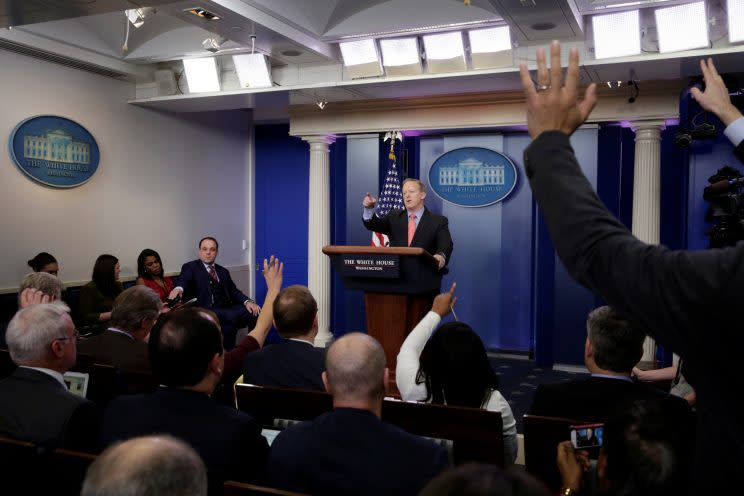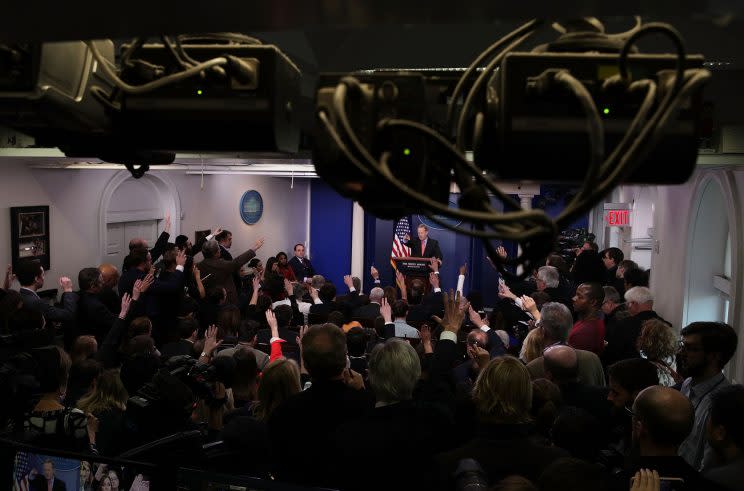D.C. outsiders get first White House briefing ‘Skype seats’

White House press secretary Sean Spicer has shaken things up in his daily briefing by sometimes calling on popular but nontraditional outlets before turning to major legacy news media. On Wednesday, Spicer will unveil another innovation by taking questions from four people in rotating virtual “Skype seats” designed to bring in voices from far outside Washington.
The inaugural class includes Natalie Herbick, a correspondent for an Ohio affiliate of Fox; Lars Larson, a conservative talk show host from Portland, Ore.; Jeff Jobe, a Kentucky community publisher and owner who supports President Trump; and Kimberly Kalunian, a reporter for a local television outlet from Spicer’s home state of Rhode Island.
“Not sure how she snuck in there,” the spokesman quipped as he announced the lineup during his daily question-and-answer session on Tuesday.
The press secretary had announced the plan for “Skype seats” at his inaugural briefing on Jan. 23, saying he aimed to “open up the briefing to journalists who live beyond 50 miles of the Washington, D.C., area.” He also wanted to include organizations that don’t have the U.S. Secret Service “hard pass” that enables reporters to enter the White House without undergoing daily background checks, as well as journalists who perhaps lack the means to travel to Washington.
“I think this can benefit us all by giving a platform to voices that are not necessarily based here in the Beltway,” Spicer said at the time.
The plan, he told Yahoo News, will be to try to do this on a daily basis. The questioners may appear on large television screens that can be mounted behind the press secretary.

It was unclear how the inaugural “Skype seats” class was put together — but it came together quickly.
“It all sort of happened today,” Kalunian told Yahoo News by telephone. Deputy White House press secretary Lindsay Walters called her to offer her a slot in the inaugural class. Kalunian enthusiastically agreed — “it’s a great opportunity for a local reporter to get that kind of access” — and 30 minutes later Spicer was announcing it from the podium.
Jobe had watched the briefing in which Spicer first laid out the proposal. “I was sitting there, watching it, and I thought, ‘It’s kind of a neat concept; maybe I’d like to do that,” he told Yahoo News by telephone.
Jobe reached out to White House deputy communications director Jessica Ditto, whom he knew from her days in Kentucky politics. “I told her, ‘I think it’s a great concept, I’d be honored to be part of that if the opportunity arises,” he recalled.
Ditto told him she had forwarded Jobe’s message to Spicer. The Kentucky publisher heard nothing more until he got a text message at 10:30 a.m. on Tuesday, asking whether he was still interested and whether he could get a reliable live Skype connection.
“I still don’t know all the details yet,” Jobe told Yahoo News.
“You’re probably going to ask whether I’m a Trump supporter. I am. I am because I think this is a new breed of politician,” he added, unprompted. “This guy’s doing exactly what he said he was going to do.”

Presidents are forever looking for new ways to reach Americans, typically building on their predecessors’ work and harnessing new or unusual means of communications. Barack Obama and George W. Bush did interviews with nontraditional outlets, like Runner’s World or YouTube stars. And many presidents have taken their message to local or regional television or to talk radio. Even in the briefing room, press secretaries face a vastly diverse press corps that can include a dizzying array of domestic and international outlets with very different audiences — and has, at this point in the Trump era, drawn in organizations that have not typically covered the White House regularly. Despite some of the angry antimedia talk from Trump and some of his top aides, Spicer has called on a variety of outlets, both established and upcoming, at his briefings.
Successive White Houses have learned that regional reporters aren’t necessarily pushovers, and that questioners who tend to agree with a candidate’s campaign promises can be the first to ask why a president has yet to keep them.
The daily White House briefing regularly comes under fire from government officials, partisans, and even reporters, but it serves important information-gathering and symbolic purposes — notably sending the message that no part of government is above being questioned.
The “Skype seats” journalists now have to decide how to use their newfound access.
“I’m going to make sure that the folks at home who watch WPRI … feel that it is a question that they would want me to ask,” Kalunian said.
And Jobe described a conundrum familiar to even the most grizzled White House press corps veteran: “I don’t even know what my question is going to be yet!”


